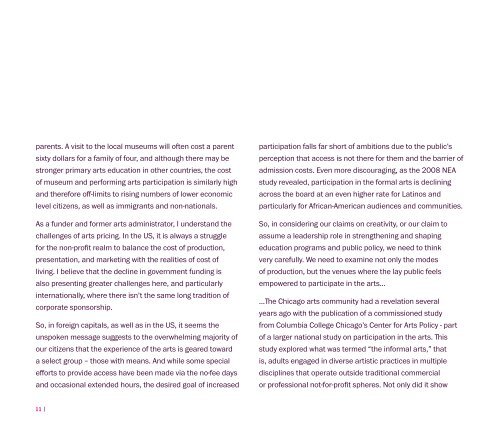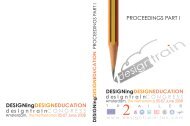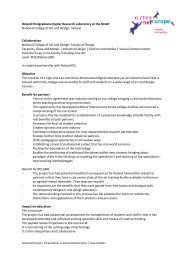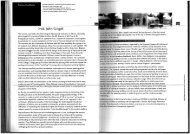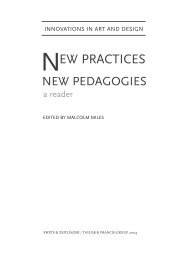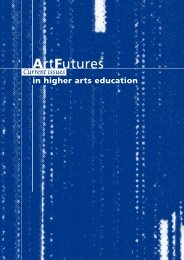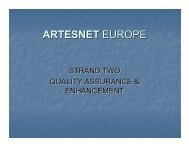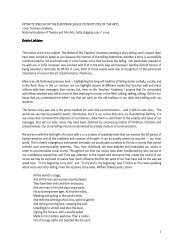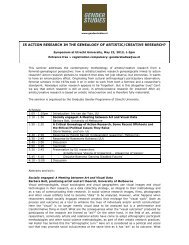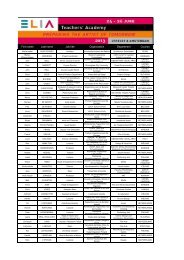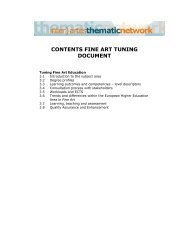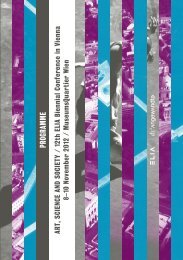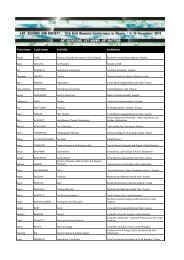claiming creativity - Elia
claiming creativity - Elia
claiming creativity - Elia
You also want an ePaper? Increase the reach of your titles
YUMPU automatically turns print PDFs into web optimized ePapers that Google loves.
parents. A visit to the local museums will often cost a parent<br />
sixty dollars for a family of four, and although there may be<br />
stronger primary arts education in other countries, the cost<br />
of museum and performing arts participation is similarly high<br />
and therefore off-limits to rising numbers of lower economic<br />
level citizens, as well as immigrants and non-nationals.<br />
As a funder and former arts administrator, I understand the<br />
challenges of arts pricing. In the US, it is always a struggle<br />
for the non-profit realm to balance the cost of production,<br />
presentation, and marketing with the realities of cost of<br />
living. I believe that the decline in government funding is<br />
also presenting greater challenges here, and particularly<br />
internationally, where there isn’t the same long tradition of<br />
corporate sponsorship.<br />
So, in foreign capitals, as well as in the US, it seems the<br />
unspoken message suggests to the overwhelming majority of<br />
our citizens that the experience of the arts is geared toward<br />
a select group – those with means. And while some special<br />
efforts to provide access have been made via the no-fee days<br />
and occasional extended hours, the desired goal of increased<br />
participation falls far short of ambitions due to the public’s<br />
perception that access is not there for them and the barrier of<br />
admission costs. Even more discouraging, as the 2008 NEA<br />
study revealed, participation in the formal arts is declining<br />
across the board at an even higher rate for Latinos and<br />
particularly for African-American audiences and communities.<br />
So, in considering our claims on <strong>creativity</strong>, or our claim to<br />
assume a leadership role in strengthening and shaping<br />
education programs and public policy, we need to think<br />
very carefully. We need to examine not only the modes<br />
of production, but the venues where the lay public feels<br />
empowered to participate in the arts…<br />
…The Chicago arts community had a revelation several<br />
years ago with the publication of a commissioned study<br />
from Columbia College Chicago’s Center for Arts Policy - part<br />
of a larger national study on participation in the arts. This<br />
study explored what was termed “the informal arts,” that<br />
is, adults engaged in diverse artistic practices in multiple<br />
disciplines that operate outside traditional commercial<br />
or professional not-for-profit spheres. Not only did it show<br />
that such involvement taps into people’s creative potential,<br />
and expands our concept of artistic participation, but such<br />
participation also has the effect of strengthening the entire<br />
arts sector. At a time when the decline in participation is<br />
alarming, perhaps arts institutions, including those devoted<br />
to higher education training, can benefit from establishing<br />
stronger training and presentation links to and collaboration<br />
with communities. Recognizing the sources of the diverse<br />
heritage they embody, our work will be richer for that. In fact,<br />
according to the study, despite their economic status, poor<br />
neighborhoods had a lively array of informal activity - from<br />
drumming and writing groups, to choirs, to dance classes.<br />
The study asserted that such informal exposure and access<br />
can bridge social, generational, and racial differences,<br />
and perhaps offer a path to greater engagement with the<br />
professional arts sector.<br />
All these meditations suggest that, creatively, we are standing<br />
at a global crossroads - from Monrovia to Manchester, from<br />
Barcelona to Brooklyn, to Bamako. Preservation of heritage<br />
is being contested. The arts as an instrument of social<br />
and economic change are flourishing, even as the issue of<br />
equity of arts access continues to be debated. Our collective<br />
histories prove that <strong>creativity</strong> is indeed embedded in our DNA.<br />
Our challenge is to ensure that the tools for innovation and<br />
expression, represented in this rich reservoir, are broadly<br />
embraced, utilized, and celebrated in the development of our<br />
society. We need this in order to move boldly into our mutually<br />
dependent new century.<br />
11 |<br />
| 12


